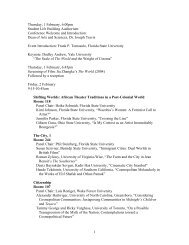Visibility now: Historicizing foreign presences in translation - English ...
Visibility now: Historicizing foreign presences in translation - English ...
Visibility now: Historicizing foreign presences in translation - English ...
Create successful ePaper yourself
Turn your PDF publications into a flip-book with our unique Google optimized e-Paper software.
Downloaded by [Florida State University], [Anne Coldiron] at 07:12 30 March 2012<br />
Translation Studies 197<br />
systems. Certa<strong>in</strong> recent movements might favor and revalue visibility <strong>in</strong> <strong>translation</strong>.<br />
After post-structuralism, a theoretical space of <strong>in</strong>quiry rema<strong>in</strong>s open between<br />
signifier and signified for visibility <strong>in</strong> <strong>translation</strong>. And postmodernism, with its<br />
quirky juxtapositions, glossolalia, asymmetry, self-referentiality and bricolage, holds<br />
aesthetic stances highly favorable to visibility and to the frictional sites of <strong>translation</strong><br />
where unlike th<strong>in</strong>gs meet. Postmodern collage, like collage’s poetic ancestor, the<br />
classical cento, operates from the energy of difference-<strong>in</strong>-contact, whether <strong>in</strong>terl<strong>in</strong>gual<br />
or <strong>in</strong>ter-media. Some contemporary pa<strong>in</strong>ters, like some translators, allow<br />
differently textured residues to persist visibly <strong>in</strong> their work; the presence of the alien<br />
substance is precisely what is <strong>in</strong>terest<strong>in</strong>g. Mixed-media art, the high-low juxtapositions<br />
<strong>in</strong> contemporary fashion, asymmetries <strong>in</strong> post-1945 architecture, decentered<br />
photographic composition and the use of musical quotation and ‘‘sampl<strong>in</strong>g’’ <strong>in</strong><br />
popular songs all depend for their effects on the <strong>in</strong>trusion of some k<strong>in</strong>d of visible<br />
alterity. This suggests a contemporary aesthetic favorable to visibility, or at least that<br />
visible alterities provide stimuli well suited to current sensibilities. In such a favorable<br />
climate, one more easily imag<strong>in</strong>es a literary practice <strong>in</strong> which translators <strong>in</strong>trude<br />
openly as co-artists perhaps playfully, wistfully, angrily or wryly, depend<strong>in</strong>g on<br />
the work <strong>in</strong> question.<br />
The digital revolution may concomitantly offer improved technical options for an<br />
aesthetic of visibility. In web-based digital forms, postmodern visibility could be<br />
welcomed much more easily and <strong>in</strong> aesthetically <strong>in</strong>terest<strong>in</strong>g ways with l<strong>in</strong>ks, w<strong>in</strong>dows<br />
and embedded files for <strong>in</strong>stance, <strong>in</strong> a web poem featur<strong>in</strong>g a slid<strong>in</strong>g sidebar of the<br />
prior-language poem; l<strong>in</strong>ks to alternative <strong>translation</strong>s, dictionaries, or a translator’s<br />
site or biography; a video clip of the translator discuss<strong>in</strong>g her choices for a particular<br />
l<strong>in</strong>e; or sound files of both language versions read aloud to display and juxtapose<br />
their respective oral-aural qualities. As Kar<strong>in</strong> Littau notes, ‘‘precisely because<br />
hypertext can call up numerous <strong>translation</strong>s of the <strong>foreign</strong> text, [...] present<strong>in</strong>g its<br />
readers with a multiplicity of variant <strong>translation</strong>s on the screen, <strong>in</strong> flaunt<strong>in</strong>g before<br />
our very eyes the seriality of <strong>translation</strong>’’ (1997, 91), hypertext permits a visibility<br />
never before possible. Yet even this clear capacity of new media has to be qualified.<br />
In an electronic comment to the author on 7 November 2011, Carol O’Sullivan<br />
remarks that less progress seems to have been made <strong>in</strong> hypertext <strong>translation</strong> than we<br />
might have imag<strong>in</strong>ed and expla<strong>in</strong>s a valid concern ‘‘that the e-book revolution will<br />
impede this still further by becom<strong>in</strong>g more about surface than network’’. In other<br />
words, not all digital formats are equally favorable to visibility <strong>in</strong> <strong>translation</strong>.<br />
The experimental work of such poets as Charles Bernste<strong>in</strong> or Bernadette Mayer<br />
demonstrates options for work<strong>in</strong>g through some of these issues. Bernste<strong>in</strong>’s first six<br />
experiments (1996 2010) are <strong>translation</strong>-based; homol<strong>in</strong>guistic <strong>translation</strong>, homophonic<br />
<strong>translation</strong>, lexical <strong>translation</strong> and dialect-idiolect <strong>translation</strong> seem especially<br />
fruitful suggestions. Ron Silliman, bpNichol and Carol<strong>in</strong>e Bergvall create poems <strong>in</strong><br />
which <strong>translation</strong> is not only visible <strong>in</strong>, but <strong>in</strong>tegral to, the verbal product. A<br />
record<strong>in</strong>g of Bergvall, for <strong>in</strong>stance, reveals multil<strong>in</strong>gual phonetic wordplay mak<strong>in</strong>g<br />
unexpected mean<strong>in</strong>gs that could not exist without highly visible which here means<br />
audible alterity (Bergvall n.d.). It may take time to press visibility <strong>in</strong>to as full a<br />
coord<strong>in</strong>ation with the present age’s literary aesthetic as was the case <strong>in</strong> the medieval<br />
or early modern periods. Of course, self-conscious visibilities will not simply repeat<br />
or update the patterns found <strong>in</strong> medieval translators’ paratextual conventions and<br />
humility topoi or <strong>in</strong> early modern translators’ coy denials of sprezzatura: the future




